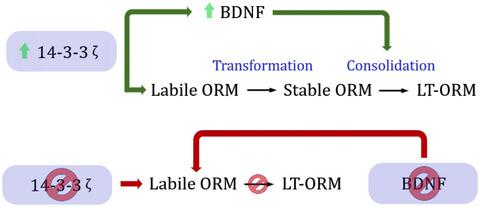当前位置:
X-MOL 学术
›
J. Neurosci. Res.
›
论文详情
Our official English website, www.x-mol.net, welcomes your
feedback! (Note: you will need to create a separate account there.)
14-3-3ζ is crucial for the conversion of labile short-term object recognition memory into stable long-term memory
Journal of Neuroscience Research ( IF 2.9 ) Pub Date : 2021-06-11 , DOI: 10.1002/jnr.24894 Irene Navarro-Lobato 1, 2, 3 , Mariam Masmudi-Martín 1, 2, 4 , Maria E Quiros-Ortega 1, 2 , Celia Gaona-Romero 1, 2 , Marta Carretero-Rey 1, 2 , Cristina Rey Blanes 1, 2 , Zafar U Khan 1, 2, 5
Journal of Neuroscience Research ( IF 2.9 ) Pub Date : 2021-06-11 , DOI: 10.1002/jnr.24894 Irene Navarro-Lobato 1, 2, 3 , Mariam Masmudi-Martín 1, 2, 4 , Maria E Quiros-Ortega 1, 2 , Celia Gaona-Romero 1, 2 , Marta Carretero-Rey 1, 2 , Cristina Rey Blanes 1, 2 , Zafar U Khan 1, 2, 5
Affiliation

|
The consolidation of new memories into long-lasting memories is multistage process characterized by distinct temporal dynamics. However, our understanding on the initial stage of transformation of labile memory of recent experience into stable memory remains elusive. Here, with the use of rats and mice overexpressing a memory enhancer called regulator of G protein signaling 14 of 414 amino acids (RGS14414) as a tool, we show that the expression of RGS14414 in male rats' perirhinal cortex (PRh), which is a brain area crucial for object recognition memory (ORM), enhanced the ORM to the extent that it caused the conversion of labile short-term ORM (ST-ORM) expected to last for 40 min into stable long-term ORM (LT-ORM) traceable after a delay of 24 hr, and that the temporal window of 40 to 60 min after object exposure not only was key for this conversion but also was the time frame when a surge in 14-3-3ζ protein was observed. A knockdown of 14-3-3ζ gene abrogated both the increase in 14-3-3ζ protein and the formation of LT-ORM. Furthermore, this 14-3-3ζ upregulation increased brain-derived growth factor (BDNF) levels in the time frame of 60 min and 24 hr and 14-3-3ζ knockdown decreased the BDNF levels, and a deletion of BDNF gene produced loss in mice ability to form LT-ORM. Thus, within 60 min of object exposure, 14-3-3ζ facilitated the conversion of labile ORM into stable ORM, whereas beyond the 60 min, it mediated the consolidation of the stable memory into long-lasting ORM by regulating BDNF signaling.
中文翻译:

14-3-3ζ对于将不稳定的短期物体识别记忆转化为稳定的长期记忆至关重要
将新记忆整合为持久记忆是一个多阶段的过程,其特点是具有不同的时间动态。然而,我们对近期经验的不稳定记忆转化为稳定记忆的初始阶段的理解仍然难以捉摸。在这里,通过使用过表达称为 G 蛋白信号 14 的 414 个氨基酸 (RGS14 414 ) 的调节剂的记忆增强剂的大鼠和小鼠作为工具,我们表明 RGS14 414的表达在雄性大鼠的鼻周皮层 (PRh) 中,这是一个对物体识别记忆 (ORM) 至关重要的大脑区域,增强了 ORM 到它导致预期持续的不稳定短期 ORM (ST-ORM) 转换的程度40 分钟进入稳定的长期 ORM (LT-ORM) 可在 24 小时延迟后追踪,物体暴露后 40 到 60 分钟的时间窗口不仅是这种转换的关键,而且也是激增的时间框架在 14-3-3ζ 蛋白中观察到。14-3-3ζ 基因的敲低消除了 14-3-3ζ 蛋白的增加和 LT-ORM 的形成。此外,这种 14-3-3ζ 上调在 60 分钟和 24 小时的时间范围内增加了脑源性生长因子 (BDNF) 水平,而 14-3-3ζ 敲低降低了 BDNF 水平,并且 BDNF 基因的缺失产生了小鼠形成 LT-ORM 的能力。因此,
更新日期:2021-08-11
中文翻译:

14-3-3ζ对于将不稳定的短期物体识别记忆转化为稳定的长期记忆至关重要
将新记忆整合为持久记忆是一个多阶段的过程,其特点是具有不同的时间动态。然而,我们对近期经验的不稳定记忆转化为稳定记忆的初始阶段的理解仍然难以捉摸。在这里,通过使用过表达称为 G 蛋白信号 14 的 414 个氨基酸 (RGS14 414 ) 的调节剂的记忆增强剂的大鼠和小鼠作为工具,我们表明 RGS14 414的表达在雄性大鼠的鼻周皮层 (PRh) 中,这是一个对物体识别记忆 (ORM) 至关重要的大脑区域,增强了 ORM 到它导致预期持续的不稳定短期 ORM (ST-ORM) 转换的程度40 分钟进入稳定的长期 ORM (LT-ORM) 可在 24 小时延迟后追踪,物体暴露后 40 到 60 分钟的时间窗口不仅是这种转换的关键,而且也是激增的时间框架在 14-3-3ζ 蛋白中观察到。14-3-3ζ 基因的敲低消除了 14-3-3ζ 蛋白的增加和 LT-ORM 的形成。此外,这种 14-3-3ζ 上调在 60 分钟和 24 小时的时间范围内增加了脑源性生长因子 (BDNF) 水平,而 14-3-3ζ 敲低降低了 BDNF 水平,并且 BDNF 基因的缺失产生了小鼠形成 LT-ORM 的能力。因此,











































 京公网安备 11010802027423号
京公网安备 11010802027423号